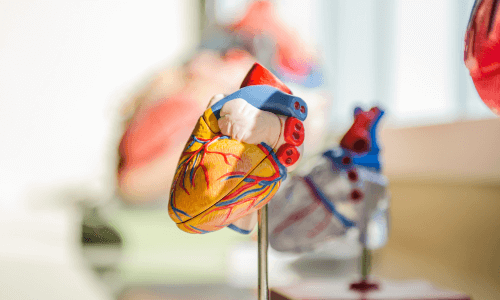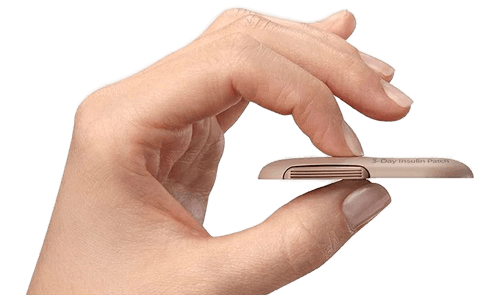Administering Bolus Insulin Manually With a Wearable Patch
Most clinicians and people with diabetes are familiar with conventional insulin delivery devices like pens, smart pens and pumps. But not everyone is aware of the bolus-only insulin patch. This newer option offers a variety of potential benefits for a subset of insulin users that warrants a closer look.
What is a Bolus-Only Insulin Patch and Who is it Indicated for?
The CeQur Simplicity insulin patch is currently the only product in this category. The patch is a small, easy to use and teach device that attaches to the user’s skin (typically the stomach) and administers up to two units of insulin on demand by manually clicking its side buttons.
The patch is indicated for mealtime and correction bolusing in people with diabetes who are 21 years and older. For those who also need basal insulin, it may be used along with an injected long-acting insulin.
High Level Specifications
| FEATURES | DESCRIPTION |
| Size | 2.5 inches long x 1.4 inches wide x 0.3 inches high, weighs 0.4 ounces |
| Capacity | Minimum fill is 100units, maximum fill is 200 units |
| Units used to prime device | 20 units |
| Bolus Increment | 2 units |
| Method of bolus delivery | Pinch both sides of device with pincer grasp |
| Approved length of wear | Up to 3 days (replaces up to 9 mealtime injections with pen/syringe) |
| Insulins approved for use in device | Humalog U100 or Novolog U100 |
| Water resistance | 30 minutes at 3.28 feet (1 meter). Can be worn swimming, bathing, showering, but not in hot tubs |
What are the Primary Clinical Benefits of a Bolus-only Insulin Patch?
Studies by CeQur show that participants:
- Increased their TIR1
- Decreased their A1C 1
- Reported less missed doses2
- Reported fewer glucose spikes2
Who Might Benefit from Using a Bolus-Only Insulin Patch?
A person looking for new options in insulin delivery and who:
- Is not tech savvy, needs a simple device: The wearable insulin patch provides an option for those who may not be comfortable with technology. Unlike insulin pumps and automated insulin delivery systems, the insulin patch requires no programming, no reliance on digital technology. The user places the device every 3 days and then anytime insulin is required they manually squeeze the sides to deliver a bolus.
- Prefers discretion: The insulin patch is an option for people who prefer not to inject in front of others. They may skip their mealtime insulin and correction doses when their glucose levels are high. Since the device is attached to the body, dosing can be done discreetly.
- Doesn’t want to carry insulin supplies with them: By wearing the patch, the person has insulin with them at all times and can avoid missing doses. Although, as with any insulin delivery method, a back-up plan and supplies are always recommended.
- Has difficulty or fear using insulin pens or syringes: Individuals who forget steps to using an insulin syringe or pen or find them difficult may find the simple step of pinch grasping both sides of the patch easier. For those with low numeracy skills, the concept of “pinching 5 times” may be easier than “draw up 10 units”. Some people have a fear of needles or would prefer a patch to dealing with a needle stick with every injection.
What are Potential Challenges to Consider?
Vision Issues: To ensure success, accommodations to help someone measure out the proper insulin dose needs to be provided by the care team for those with limited vision.
Dexterity Limitations: Additionally, accommodations to help someone measure out the proper insulin dose needs to be provided by the care team for those with dexterity limitations. The user needs to be able to fill the device with the proper amount of insulin every 3 days (or less), attach the device to their body using the reusable inserter, and pinch the 2 sides simultaneously to deliver the dose. Dexterity issues may impact a person’s ability to perform these tasks.
Skin Sensitivity: If a person has sensitive skin, having a patch adhered to the skin may require some additional attention to ensure proper skin health and decrease skin reactivity. There are products on the market to help with skin preparation, cleansing, and adhesive removal along with adherents and coverings to keep the patch attached for the wear period.
Low Tech = No data: For those working closely with health care providers and diabetes care and education specialists, there is no data available to share and review, which can make visits and future recommendations for insulin optimization a challenge. Consider using the CeQur Simplicity with a CGM.
How is it Prescribed?
To use CeQur Simplicity, these prescriptions are required:
- 1 month supply: CeQur Simplicity 2U Patch with 10 patches
- The reusable CeQur Simplicity Inserter Kit
- Vial(s) of Fast acting insulin (Humalog-100 or Novolog-100)
For more specific prescription details, visit danatech’s CeQur product page.
Cost, Coverage, and Affordability
CeQur Simplicity is covered on most commercial and Medicare Part D insurance plans as a pharmacy benefit. Where covered, most patients have a co-pay of $50 or less a month.
Recent online research indicates retail cost for 10 patches is around $380, or $38 per patch. Visit our CeQur product page for more information.
Preparing and Using the Bolus-Only Insulin Patch
These are the 4 steps to follow:
- Preparing the Patch: Using an insulin syringe, inject amount of rapid acting insulin needed for a 3-day wear into the patch. For those who also need basal insulin, it may be used along with an injected long-acting insulin. Consider the amount of insulin needed to dose for all meals, snacks, and correction doses for high blood glucose values plus 20 units (required for priming). If this number is higher than the capacity of the patch, it will need to be replaced earlier than the 3-day wear time.
- Placing the Patch: Once the patch is filled with insulin and primed, it is affixed to the body on the abdomen with a reusable applicator. An inserter needle is used to attach the patch to the body, but it is then discarded. The flexible cannula of the patch which stays under the skin, delivers insulin during the wear period of up to three (3) days.
- Using the Patch: Simply pinch the buttons on each side using a pincer grip to administer two units of insulin at a time for mealtime boluses or any other time it’s needed. The user will feel and hear an audible click when insulin has been given. While slightly more challenging, the reason for needing to click two buttons versus just one is to prevent accidental overdosing.
- Removing the Patch: The patch can be used for up to 3 days (replaces up to 9 mealtime injections with pen/syringe). To remove simply pull one edge of the adhesive patch like you are removing a band-aid and dispose of the device according to local regulations.
Other Important Training Points to Teach New Users
- Insulin fill amount calculations
- How many clicks to use for various meals, snacks, and high blood sugars is required
- Proper site rotation to maintain healthy skin and avoid infection
- Proper patch placement, orientation, and removal
- Disposal recommendations
Summary
The bolus-only insulin patch is another option for individuals taking insulin who need a low tech, convenient way to administer bolus insulin. Like all insulin delivery devices, the person’s preferences, lifestyle, and insurance coverage should be fully considered in order to determine the insulin delivery device that will give them the best long-term outcomes.
For more details, visit our CeQur product page and follow the links for training and education, affordability programs and more.
Related Topics
Device Overview & Training: Hands on with CeQur Simplicity, a 3-day wearable mealtime insulin patch
References
1. Bergenstal R, Peyrot M, Dreon, D. et.al. on behalf of the Calibra Study Group. 2019. Implementation of Basal-Bolus Therapy in Type 2 Diabetes: A Randomized Controlled Trial Comparing Bolus Insulin Delivery Using an Insulin Patch with an Insulin Pen. Diabetes Technology and Therapeutics 21 (5):1-13.
2. Johnson ML, Dreon DM, Levy BL, et.al. 2018. Comparing Patch vs. Pen Bolus Insulin Delivery in Type 2 Diabetes Using Continuous Glucose Monitoring Metrics and Profiles. Diabetes 2018 Jul; 67(Supplement 1).


 Guidance on clinical assessment, adjustments, report interpretation and key education. Designed to be used during clinic visits.
Guidance on clinical assessment, adjustments, report interpretation and key education. Designed to be used during clinic visits.-(3).jpg?sfvrsn=16486d59_5)
 Proper basal insulin initiation and titration can help reduce therapeutic inertia and engage patients in their diabetes management. Find videos, podcasts and other resources to fine tune your knowledge.
Proper basal insulin initiation and titration can help reduce therapeutic inertia and engage patients in their diabetes management. Find videos, podcasts and other resources to fine tune your knowledge.
 An overview of Glycemic Management Platforms that answers key questions including: What are they? What to consider? How can my inpatient facility benefit and more.
An overview of Glycemic Management Platforms that answers key questions including: What are they? What to consider? How can my inpatient facility benefit and more.


 Certificate programs, webinars and courses related to cardiometabolic health and diabetes. Topics include weight loss, treatments, lifestyle enhancements, the latest technological advancements and more.
Certificate programs, webinars and courses related to cardiometabolic health and diabetes. Topics include weight loss, treatments, lifestyle enhancements, the latest technological advancements and more. Find danatech's interactive diabetes technology tools for point-of-care, insurance coverage and more.
Find danatech's interactive diabetes technology tools for point-of-care, insurance coverage and more.













